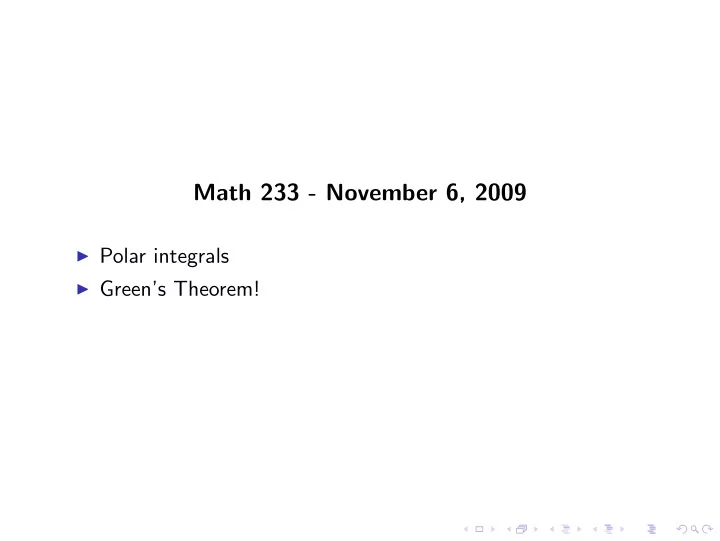

Math 233 - November 6, 2009 ◮ Polar integrals ◮ Green’s Theorem!
1. Use rectangular coordinates to compute � π/ 4 � sec θ r 3 sin 2 θ dr d θ = 0 0 2. Use polar coordinates to compute the volume between the graphe of z = 1 − x 2 − y 2 and the xy -plane. V = 3. Use polar coordinates to compute (this is probably not an integral that you would actually want to change to polar, but you should be able to anyway) � y � 2 y dx dy = 1 − y
1. Use rectangular coordinates to compute � π/ 4 � sec θ � 1 � x y 2 dy dx = 1 r 3 sin 2 θ dr d θ = 12 0 0 0 0 2. Use polar coordinates to compute the volume between the graphe of z = 1 − x 2 − y 2 and the xy -plane. � 2 π � 1 (1 − r 2 ) r dr d θ = π V = 2 0 0 3. Use polar coordinates to compute (this is probably not an integral that you would actually want to change to polar, but you should be able to anyway) � 2 � y � 3 π/ 4 � 2 csc θ r 2 sin θ dr d θ = 14 y dx dy = 3 1 − y π/ 4 csc θ
Lecture Problems 4. Use Green’s theorem to compute the line integrals (a) Let C be the closed curve oriented counter clockwise formed √ by y = x / 2 and y = 2 between (0 , 0) and (4 , 2). � 2 xy dx + y 2 dy = C (b) Let C be the closed curve oriented counter clockwise formed by y = 0 and x = 2 and y = x 3 / 4. � (2 x + y 2 ) dx + ( x 2 + 2 y ) dy = C (c) Let C be the ellipse, 9 x 2 + 16 y 2 = 144 oriented counter clockwise. � ( x 2 + 4 xy ) dx + (2 x 2 + 3 y ) dy = C
Lecture Problems 4. Use Green’s theorem to compute the line integrals (a) Let C be the closed curve oriented counter clockwise formed √ by y = x / 2 and y = 2 between (0 , 0) and (4 , 2). � 2 � 2 y � y 2 − 2 x dx dy = − 64 2 xy dx + y 2 dy = 15 C 0 (b) Let C be the closed curve oriented counter clockwise formed by y = 0 and x = 2 and y = x 3 / 4. � 2 � x 3 / 4 2 x − 2 y dy dx = 72 � (2 x + y 2 ) dx +( x 2 +2 y ) dy = 35 C 0 0 (c) Let C be the ellipse, 9 x 2 + 16 y 2 = 144 oriented counter clockwise. � �� ( x 2 + 4 xy ) dx + (2 x 2 + 3 y ) dy = 0 dA = 0 C R
Recommend
More recommend